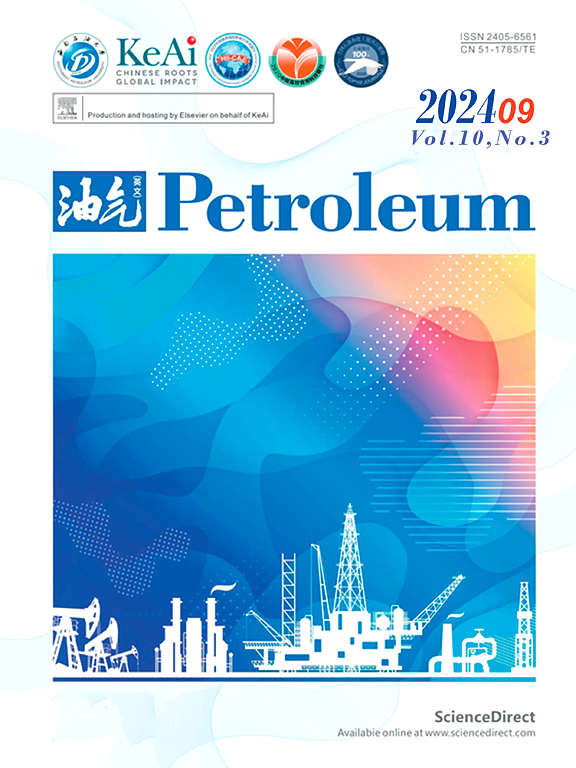水-二氧化碳交替注入工艺及其衍生产品,以提高地下油藏的采收率和二氧化碳储量
IF 3.5
Q2 ENERGY & FUELS
引用次数: 0
摘要
不断增加的二氧化碳水平对生态系统产生了重大影响,促使石油行业探索减少排放和捕获二氧化碳的创新方法,同时提高石油采收率。其中,水-气交替CO2 (WAG-CO2)注入工艺已成为优化地下储层油气开采的关键技术。WAG-CO2结合了注水和利用二氧化碳的优点,提高了石油生产效率,并提供了一种潜在的二氧化碳储存解决方案。这篇小型综述深入探讨了WAG注入的多个方面,包括表面活性剂交替气(SAG)和低矿化度水交替气(LS-WAG)等高级变体。此外,它还探讨了该领域的最新进展,例如二氧化碳交替纳米水(NWAG)和泡沫辅助纳米水(FWAG)注入,强调了这些技术的发展。WAG与聚合物注入和流动性控制技术的集成产生了协同效应,扩大了WAG方法的适用性。本文全面分析了WAG及其衍生物在提高采收率(EOR)方面的潜力,同时解决了当前的挑战和未来的趋势,从而为石油工业的可持续发展做出了贡献。本文章由计算机程序翻译,如有差异,请以英文原文为准。
A mini-review of water-alternating-CO2 injection process and derivations for enhanced oil recovery and CO2 storage in subsurface reservoirs
Increasing carbon dioxide levels are significantly impacting the ecosystem, prompting the oil industry to explore innovative methods for reducing emissions and trapping CO2 while enhancing oil recovery. Among these, the water-alternating-gas CO2 (WAG-CO2) injection process has emerged as a crucial technique for optimizing hydrocarbon extraction from subsurface reservoirs. WAG-CO2 combines the benefits of water injection with the utilization of CO2, enhancing oil production efficiency and offering a potential solution for CO2 storage. This mini-review delves into the multifaceted aspects of WAG injection, including advanced variations such as surfactant alternating gas (SAG) and low-salinity water alternating gas (LS-WAG). Furthermore, it explores recent advancements in the field, such as CO2 alternating nano water (NWAG) and foam assisted WAG (FWAG) injections, underscoring the evolution of these techniques. The integration of WAG with polymer injection and mobility control technologies produces synergistic effects, expanding the applicability of WAG methods. This review provides a comprehensive analysis of the potential of WAG and its derivatives for enhanced oil recovery (EOR) while addressing current challenges and future trends, thereby contributing to the sustainable development of the oil industry.
求助全文
通过发布文献求助,成功后即可免费获取论文全文。
去求助
来源期刊

Petroleum
Earth and Planetary Sciences-Geology
CiteScore
9.20
自引率
0.00%
发文量
76
审稿时长
124 days
期刊介绍:
Examples of appropriate topical areas that will be considered include the following: 1.comprehensive research on oil and gas reservoir (reservoir geology): -geological basis of oil and gas reservoirs -reservoir geochemistry -reservoir formation mechanism -reservoir identification methods and techniques 2.kinetics of oil and gas basins and analyses of potential oil and gas resources: -fine description factors of hydrocarbon accumulation -mechanism analysis on recovery and dynamic accumulation process -relationship between accumulation factors and the accumulation process -analysis of oil and gas potential resource 3.theories and methods for complex reservoir geophysical prospecting: -geophysical basis of deep geologic structures and background of hydrocarbon occurrence -geophysical prediction of deep and complex reservoirs -physical test analyses and numerical simulations of reservoir rocks -anisotropic medium seismic imaging theory and new technology for multiwave seismic exploration -o theories and methods for reservoir fluid geophysical identification and prediction 4.theories, methods, technology, and design for complex reservoir development: -reservoir percolation theory and application technology -field development theories and methods -theory and technology for enhancing recovery efficiency 5.working liquid for oil and gas wells and reservoir protection technology: -working chemicals and mechanics for oil and gas wells -reservoir protection technology 6.new techniques and technologies for oil and gas drilling and production: -under-balanced drilling/gas drilling -special-track well drilling -cementing and completion of oil and gas wells -engineering safety applications for oil and gas wells -new technology of fracture acidizing
 求助内容:
求助内容: 应助结果提醒方式:
应助结果提醒方式:


